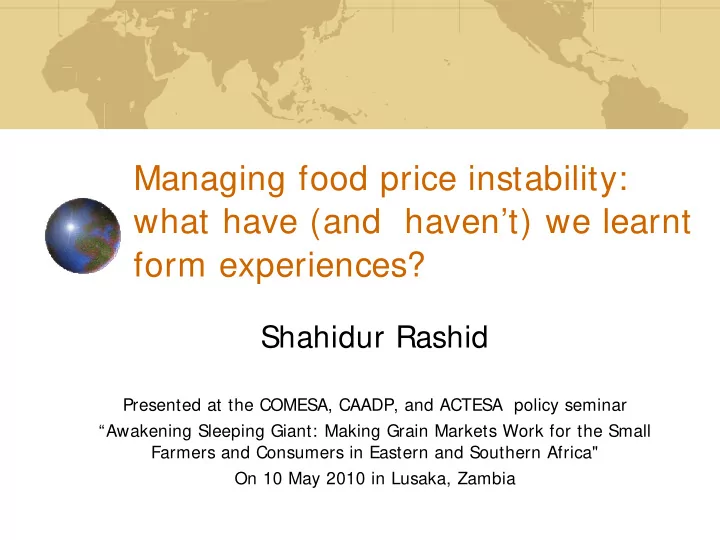

Managing food price instability: what have (and haven’t) we learnt form experiences? Shahidur Rashid Presented at the COMESA, CAADP, and ACTESA policy seminar “Awakening Sleeping Giant: Making Grain Markets Work for the Small Farmers and Consumers in Eastern and Southern Africa" On 10 May 2010 in Lusaka, Zambia
Outline Rationales for managing food price instability. Sources of food price instability and traditional policy response Critical determinants of policy success. The challenges and lessons learned .
Understanding market Process of Outcome Exchange Market PRICE
Rationales for managing price instability Commonly given rationales Economists’ terms 1 Inadequate infrastructure Public goods 2 Imperfect price information Information Asymmetry 3 Missing credit & insurance markets Institutional failure 4 Technology promotion (green Absence of risk revolution) management institutes 5 Volatility of international price Strategic response 6 Limited capacity to import Self-sufficiency/ strategic 7 Political sensitivity to price instability Strategic response
Sources of grain price variability Source of variability Explanation Weather-shocks � 1 Supply shocks � large variation in grain prices production variability Poor infrastructure High transport cost limits trade between 2 (including info) and high surplus and deficit region; and create wider gap transaction costs in import and export parity. Transmission of global World prices are volatile and the volatility gets 3 price volatility transmitted if a country in import dependent Single harvest � greater seasonal variation in 4 Unimodal rainfall grain prices Makes demand for dominant staple inelastic 5 Reliance on one staple (small supply shock � big change in price) Creates wider gap between import and export 6 Trade barriers parity, which are bounds of domestic prices Unpredictable policy Discourages private traders from investing in 7 interventions and carrying out storage and trade.
Short- and Long term policy options Effective management of food price instability requires working on the root causes. But addressing the root causes of price instability requires time. Thus, some short term interventions are thought to be justified, while countries work on the root causes. Traditional methods are short term interventions
Short- run approach has been to stabilize prices through public interventions Both developed and developing countries have practiced policies of managing price instability; but the vary across countries in terms of design and implementation Most African countries managed food price instability through marketing boards, which in some instance eliminated private sector Asian countries adopted dual pricing policies, where government control certain share of market, but majority of marketing activities were carried out by the private sector.
Short term interventions : African experiences Governments controlled all aspects of markets Set production quota at pre-set prices Prohibited private trade Pan-territorial pricing (no variation of prices across space or time) Private sector became non-existent /very small.
Key elements of Asian dual price policies. Two critical elements: (a) institutions, (b) appropriate regulations Prices commissions / food security monitoring research Clear research support Monitor costs of production; determine floor and ceiling prices; provide market information (both domestic and international) Linking price policies with social safety net program Price support to farmer � protection to vulnerable Private sector remained dominant
Distinguishing features of price policies in Africa and Asia Indicators Africa Asia during green revolt. √ & X √ 1 Smallholder dominant agriculture X √ 1 Institutional / research supports to policy formulation X √ 2 Links with strategic reserves and social safety net programs X √ 3 Clearly defined price band (floor and ceiling price) √ & X √ 4 Analytical basis of stock determination √ √ 5 Panic response (intervention)
Challenges of managing price instability (1) Political pressure from farmers to set high floor (buying) price; political pressure from consumers to set low ceiling (selling) price Managing price instability by holding stocks can be very expensive. Example of costs and food safety….. Delays in decision-making and funding mean that interventions occur late, sometimes further exacerbating the price instability It can displaces private sector from storage activities.
Challenges: once adopted, hard to get out POLICY ACTIONS OUTCOMES Higher domestic price Export liberalization Protests in urban centers Export ban Decline in domestic price Increase in Protest from the farmers procurement price Higher procurement Increase in ration Lower distribution price to lower subsidy HIGHER STOCK BUILD UPS
Long term solutions: how are we doing? Source of Policy Remedies to reduce variability Instability (attention) Production forecasting, Agric research � Weather ‐ & extension, supplementary irrigation, related shocks develop drought ‐ resistant crops � Unimodal Invest in post ‐ harvest storage rainfall technology, allow off ‐ season imports ☺ Poor transport Invest in roads, bridges, and ports infrastructure
Variation in crop forecasting 40 30 20 % Differences 10 0 -10 -20 -30 -40 2001 2002 2003 2004 2005 2006 FAO-WFP (CFSAM) minus CSA USAID (Bellmon) - CSA
Remedies for staple food variability (cont) Source of Policy Remedies to reduce variability Instability attention Grades and standards, market High transaction � information systems, commercial credit, costs contract enforcement � Commitment to open borders for grain, Trade barriers streamline paperwork at borders � Reliance on one Promote secondary staple crops staple � Unpredictable Reduce intervention in trade and policy storage, make interventions predictable intervention
Summary (1) The ultimate objective should be working on the sources of instability. We should work on turning all the sad faces into happy faces . Given frequency of emergencies and political sensitivity of price instability, short run interventions might be necessary. However, they should be: Rule based and backed by empirical analyses This will require setting up / strengthening analytical support units
Summary (2) Integrating emergency reserves with right kind of social safety nets programs. This will help: Minimize financial cost of short run policies; reduce disincentive effects; More importantly, such linkage his has the potentials to create demand, protect livelihood, and contribute towards building an educated, healthy, and productive labor force.
AMASEGANALU!!
Recommend
More recommend